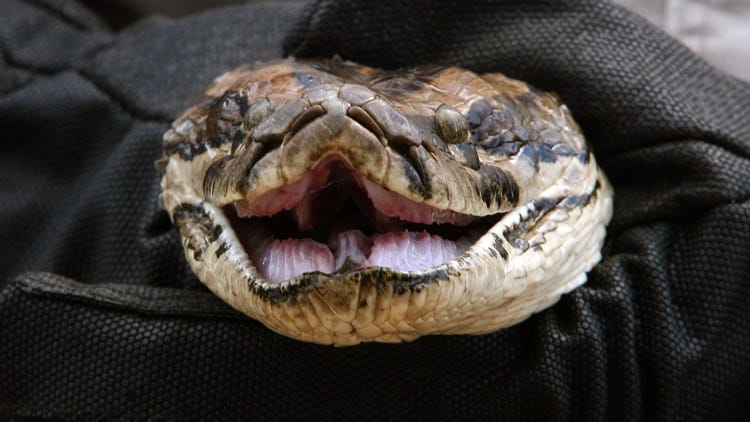In Palm Beach County, 69 Burmese pythons have been captured since 2006, according to the Early Detection and Distribution Mapping System, or EDDMapS. In addition, four have been found dead, and 24 sightings have been reported. Countless more of the invasive snakes likely have lurked undetected or unreported.
Just to the north of Palm Beach County, on the Treasure Coast, there have been at least 25 documented sightings of Burmese pythons since 2004..
Where did the Burmese pythons come from? The conventional wisdom is they were pets that escaped or were released. But there’s mounting evidence that Everglades pythons have the ability to migrate north and west from South Florida because they’re crossbreeding, evolving and adapting to other areas of Florida and the U.S.
The question is: Have they crossed the boundaries of their established breeding range, which extends from Lake Okeechobee south to Key Largo and from western Broward County west to Collier County?
The Florida Wildlife Conservation Commission and the U.S. Geological Survey would not speculate, and several other biologists, scientists and snake wranglers told TCPalm they just don’t know.
However, a 2008 study published in the peer-reviewed journal Biological Invasions says pythons are “now well established in southern Florida and spreading northward.”
“They are good at finding ways of sheltering,” said Ken Gioeli, a Natural Resources and Environment agent at the University of Florida Institute of Food and Agricultural Sciences in Fort Pierce. “Unfortunately, they are adapting.”
Florida Burmese python habitat range
This map shows the Burmese python’s established breeding ground and how the invasive snake spread from 1979 to 2021, according to the U.S. Department of the Interior’s U.S. Geological Survey Wetland and Aquatic Research Center.
Pythons have been established in the Everglades since the 1980s, but studies and sightings show the cold-blooded snakes have adapted to cooler temperatures and different habitats.
The USGS has confirmed their presence north of the Everglades through DNA identification of their saliva, excrement, shed skin and sloughed scales, said research geneticist Margaret Hunter.
Those areas are north of Lake Okeechobee in the Kissimmee River area from Orlando to Okeechobee and southwest of Lake Okeechobee in the Arthur R. Marshall Loxahatchee National Wildlife Refuge in Palm Beach County, Hunter said.
One reason they’ve adapted to higher ground is they’ve been crossbred with Indian rock pythons that prefer that habitat — likely before they were introduced into the Everglades, according to the USGS. Genetic evidence shows at least 13 out of 400 pythons studied were crossbred.
For evidence of how they’ve adapted to the cold, look no further than a 2010 Arctic blast that blew unusually and prolonged cold weather into South Florida from January to March. Scientists found the pythons that survived have a different gene than the ones that died, Hunter said.
“A substantial portion of the mainland U.S. is potentially vulnerable to this ostensibly tropical invader,” says the 2008 study in Biological Invasions.
Climate change could expand their range even more by 2100 to include New York, New Jersey, Pennsylvania, West Virginia, Ohio, Indiana, Illinois, Colorado and parts of Washington state.
Coastal and Southern states with python-conducive climates similar to the snakes’ native range in Asia — from India to China to Pakistan — include all of Florida and most of California as well as the Carolinas, Georgia, Alabama, Mississippi, Arkansas, Louisiana Oklahoma and Texas.
“They are going to continue to evolve and adapt,” Hunter said.
For now, the FWC staff evaluates reports of pythons outside their established breeding range and “release information regarding new locations of establishment and range changes.”
Removing Burmese pythons from Florida with: Python Challenge, Python Elimination Program, Python Action Team Removing Invasive Constrictors (PATRIC)
The SFWMD’s Python Elimination Program and the FWC’s Florida Python Challenge and Python Action Team Removing Invasive Constrictors are among the statewide efforts to remove pythons from the environment, which is essential because they alter food webs.
Pythons have killed 85-100% of the Everglades’ foxes, bobcats, rabbits, raccoons, possums and white-tailed deer — species that live on the Treasure Coast too.
The FWC and SFWMD contract with 100 hunters who track and remove pythons from the Everglades year-round, and the Python Challenge that FWC launched in 2013 became an annual 10-day hunting competition in 2020.
Through all the state’s efforts, over 23,000 pythons have been removed since 2000, including 917 from the hunt alone, according to FWC. Yet trappers have caught less than 1% of Florida’s python population, Hunter said, which is estimated to be in the tens of thousands and growing.
State law allows people to kill an unlimited number of pythons using humane and legal methods on 32 FWC-managed lands year-round, and on private land with the owner’s permission.
“Every python removed from the Florida landscape is one less invasive snake impacting our native wildlife and ecosystems,” FWC spokesperson Lisa Thompson said. “FWC staff encourages residents to report sightings.”
That’s not happening enough, Gioeli said.
How to report Burmese python sightings in Florida
“Every once in a while, there will be a news report of a police officer or animal control officer capturing one, but those reports never make it to the reporting sites,” he said. “I’ve tried to bridge that gap to get them to report it. I will work to let people know that the reporting system is out there. I think a lot of people are not aware that there is a reporting system.”
Call 911 or Animal Control in your city or county for an immediate threat, then report the exact location to the FWC’s Invasive Species Hotline at 888-Ive-Got1 (483-4681). Sending a photo is important because Burmese pythons can be easily confused with ball pythons.
“There is always going to be a constant need for outreach and education” about reporting pythons, Gioeli said, “because there are so many new people coming to the area.”
More on Burmese pythons in Florida
Tim O’Hara is TCPalm’s environment reporter. Contact him at tim.ohara@tcpalm.com.
This article originally appeared on Palm Beach Post: Map: Florida Burmese pythons habitats grow beyond Everglades




